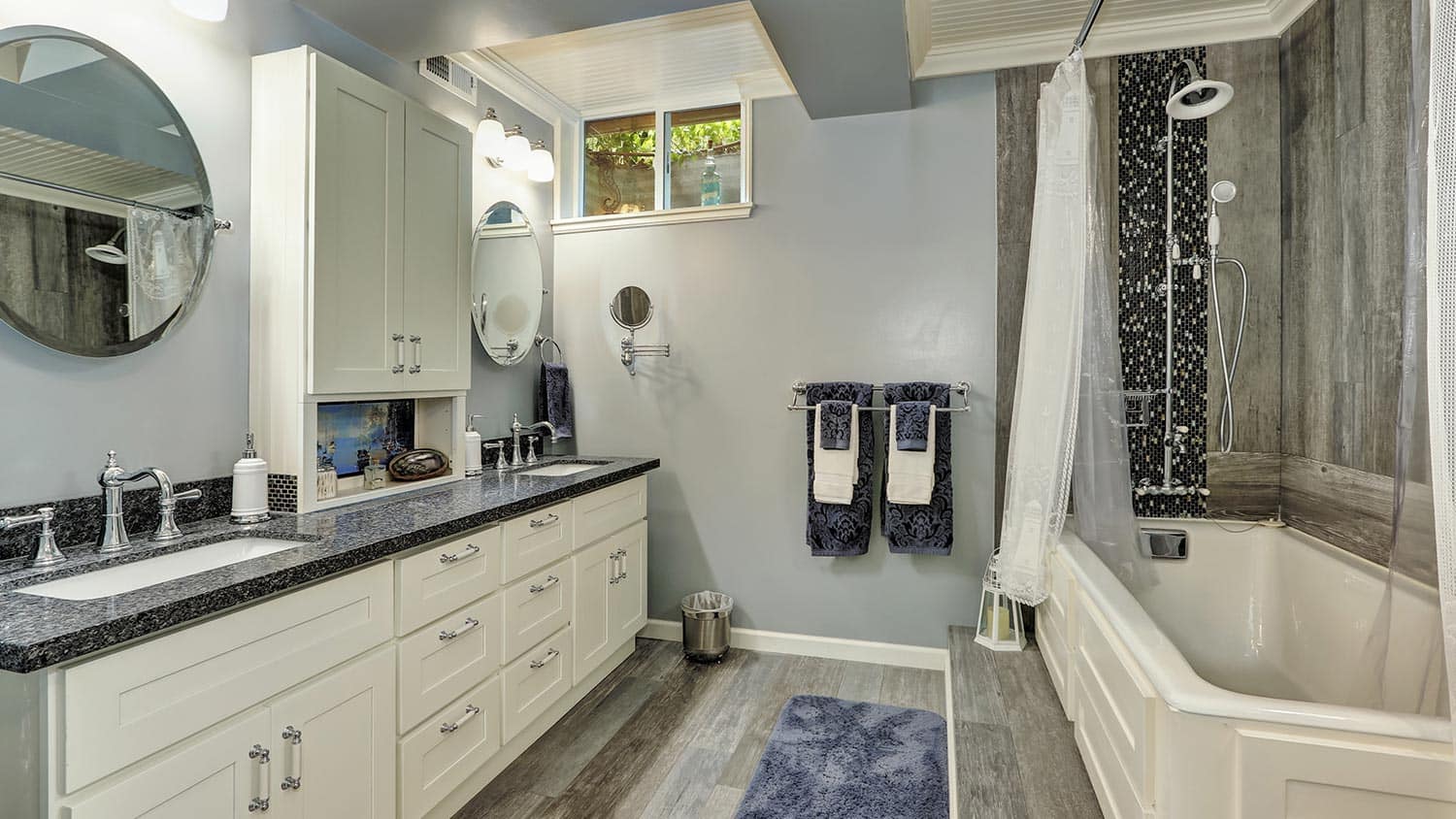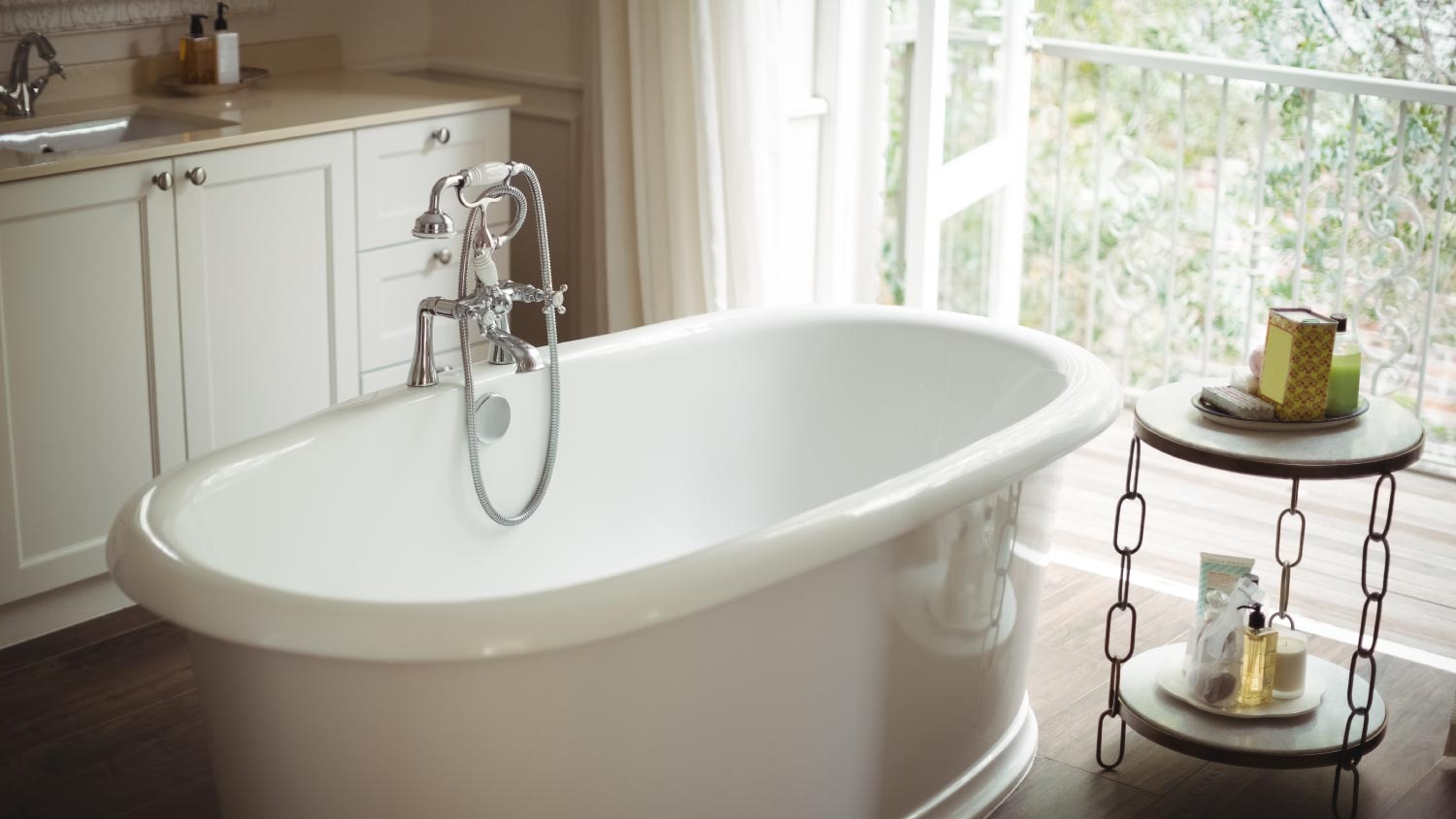
Bathroom cabinet costs can easily skyrocket. Take a look at these important cost factors and considerations to help you stay within your budget.
Increase your home’s value while adding convenience


A finished basement feels more complete with a bathroom, but you’ll need ventilation, plumbing, and electrical to get it done.
Fitting a new bathroom into a basement can be a costly and difficult DIY project.
You must consider flooring and proper drainage when adding a bathroom to a basement.
While adding a bathroom to your finished basement can be useful and a solid investment, some challenges come with belowground plumbing. You’ll need to consider drainage and ventilation when designing your belowground bathroom. This home improvement job is best left to a professional bathroom remodeler.
As with any home project, installing a bathroom in your finished basement has advantages and disadvantages. Consider each one to determine if this project is right for you.
If you decide to transform your finished basement into a kids’ playroom, a home gym, or a guest suite, adding a bathroom will only improve the space. Your guests will feel more comfortable in their own space, and you’ll no longer have the whole family running up and down the stairs to use the bathroom throughout the day. A bathroom in your finished basement is the ultimate convenience.
Adding a bathroom to your basement or remodeling an existing bathroom can also increase your home’s value. If you go with a full bathroom complete with a shower or tub, you’ll make the space fully livable. And if you also add a kitchen or kitchenette, you could even rent the space out.
If you’re considering installing a bathroom in your finished basement, consider how much space you have. Some basements are as large as the entire footprint of the upper stories of the home, but others are smaller. Keep in mind that adding a bathroom will remove some of that space, leaving less room for your treadmill or the kids’ action figure collection.
Installing a belowground bathroom isn’t a DIY-friendly project and requires a professional to work out the details. Basement bathrooms come with unique challenges—running water downstairs and back up again can be tricky, so it’s important to hire a pro who knows what they’re doing to ensure that your bathroom works properly. A local bathroom remodeler can walk you through the project and create an estimate.
Because adding a basement bathroom requires a professional as well as new plumbing systems, it can be costly. Plumbing prices vary, but this type of project can easily cost between $10,000 and $15,000.
Here are the most essential items to consider as you plan to add a bathroom to your basement.

First, contact your local building authority to understand what zoning ordinances to consider and to secure the proper permits. Then, plan your basement bathroom’s design.
Decide which style of bathroom you’d like. Your options are:
Half bath (toilet and sink only)
Full bathroom (toilet, sink, and shower or tub)
Half baths work well in basements because they’re functional but require less maintenance than full bathrooms.
Full bathrooms are nice when you’re converting your basement into a guest space. That way, they don’t have to trudge their things upstairs to take a shower. But make sure to add a high-power ventilation fan to draw out excess moisture since basements tend to be damp even without a bathroom.
You should also take your bathroom’s flooring into consideration while designing the room. Bathrooms can be wet, so the flooring you choose must withstand exposure to moisture. Vinyl, tile, and concrete are good options.
Plumbing-wise, it works best to install your basement bathroom directly below the bathroom on the upper floor. This will simplify plumbing and eliminate the need for pipes to twist and turn throughout the house, which will require more materials (and more cost).
Talk to a professional about the depth of the sewer line. If it’s deep enough, you can install belowground water and waste pipes to allow gravity to take care of waste disposal for you. But if it isn’t deep enough, which is a common occurrence, you may need to consider other waste disposal methods, including:
Upflushing toilet
If your house has a Pittsburgh toilet—a standalone basement toilet—you can finish a bathroom around it, and you may already have some of the plumbing in place.
It’s crucial to consider drainage when adding a bathroom to a basement. Unlike in above-ground plumbing, belowground plumbing can’t harness the power of gravity to drain waste towards your pipes. Your plumber can help you determine how to combat this issue to ensure proper drainage and waste disposal.
Some basements will have deep drainage lines, which makes waste disposal a bit easier since gravity can get to work. But in cases where those lines aren’t deep enough, you may need to tear up part of your basement floor and dig into the ground below it to create sufficient fall that will encourage proper drainage.
Your plumber is the best resource here, as plumbing systems vary from home to home. Installing a bathroom in your basement can be difficult and costly, but most homeowners find it to be worth it in the end.
If your basement bathroom will be used frequently, you may need to consider storage space–like a linen closet–in your design plans. It might make the bathroom project larger, but it’s worth getting it done right, especially if you need the space.
Since this bathroom will be in your basement, you should be extra careful when selecting your flooring material. You should avoid using solid hardwood and laminate flooring in a basement bathroom, as these materials are prone to buckle and warp when exposed to excess moisture.

Adding a bathroom to your basement will cost between $10,000 and $15,000, depending on how much plumbing and electrical you need to add. You’ll also pay more for luxury materials and special drainage if you’re below the water table. Building a basement bathroom directly underneath an existing bathroom can reduce plumbing costs in some cases, as well as take other existing architecture like columns and existing walls into account.
| Features for a Bathroom | Average Cost Range |
|---|---|
| Rough-in plumbing | $3,000–$20,000 |
| Electrical | $500–$2,500 |
| Adding walls | $20–$30 per linear foot |
| Bathroom flooring | $2–$35 per square foot |
| Bathroom fan | $240–$600 |
| Bathroom countertops | $400–$4,300 |
| Faucet | $170–$360 |
| Sink | $215–$625 |
| Toilet | $350–$4,000 |
| Shower | $1,150–$8,000 |
| Bathtub | $200–$12,000 |
| Light fixtures | $175–$1,100 |
If you have the skills and tools to safely and properly install a bathroom in your basement, it could save you money on the cost of labor. That being said, you may want to contact a basement contractor near you and have them do the job if you’re hesitant about it or don’t have the time to do it yourself. Plumbing and electrical have to be worked on by licensed professionals, and DIY mistakes can lead to costly repairs. With this in mind, hiring a pro for the job is the best way to go.
Mayflower was an excellent choice for the complete renovation of my condominium. They knew exactly how to deal with the complexities of the condo building and management to make the project very smooth, easy and done right. From start to finish, everyone was incredibly helpful and their...
After inheriting my grandparents old farmhouse, I knew it needed a lot of work to become livable. Construction Nation tackled the challenge head-on. They remodeled the kitchen and bathroom while preserving the home s rustic charm. The team was respectful, hardworking, and their craftsmanship...
We contracted NY Galaxy General Contracting to complete a recent, entire home renovation, this included bedroom, living room, kitchen and bathrooms. The project was seamless and completed just in time.I highly recommend them as they are extremely professional and truly care about their...
Alex and his crew are great! I contracted them to move my dad and they went above and beyond!
Excellent sales staff and installer. Easy to work with. I appreciated that my current system was able to be activated and used.
From average costs to expert advice, get all the answers you need to get your job done.

Bathroom cabinet costs can easily skyrocket. Take a look at these important cost factors and considerations to help you stay within your budget.

Remodeling your bathroom can add significant value to your home. Your bathroom remodel cost in New York, NY will depend on size, fixtures, materials, labor, and other factors.

Shower installation costs in New York, NY depend on size, style, and materials. No matter the budget, this guide can help you plan your project and even save a few bucks.

An updated bathtub can give a bathroom a whole new look. Find out how much it costs to replace a bathtub in Los Angeles, CA, including prices by type and labor costs.

From increasing resale value to being tricky to maintain, there are plenty of pros and cons of copper kitchen sinks. Figure out if they’re right for you.

Planning a home renovation? Here’s how to avoid common house remodeling mistakes, so you can enjoy a picture-perfect home and save money in the long run.